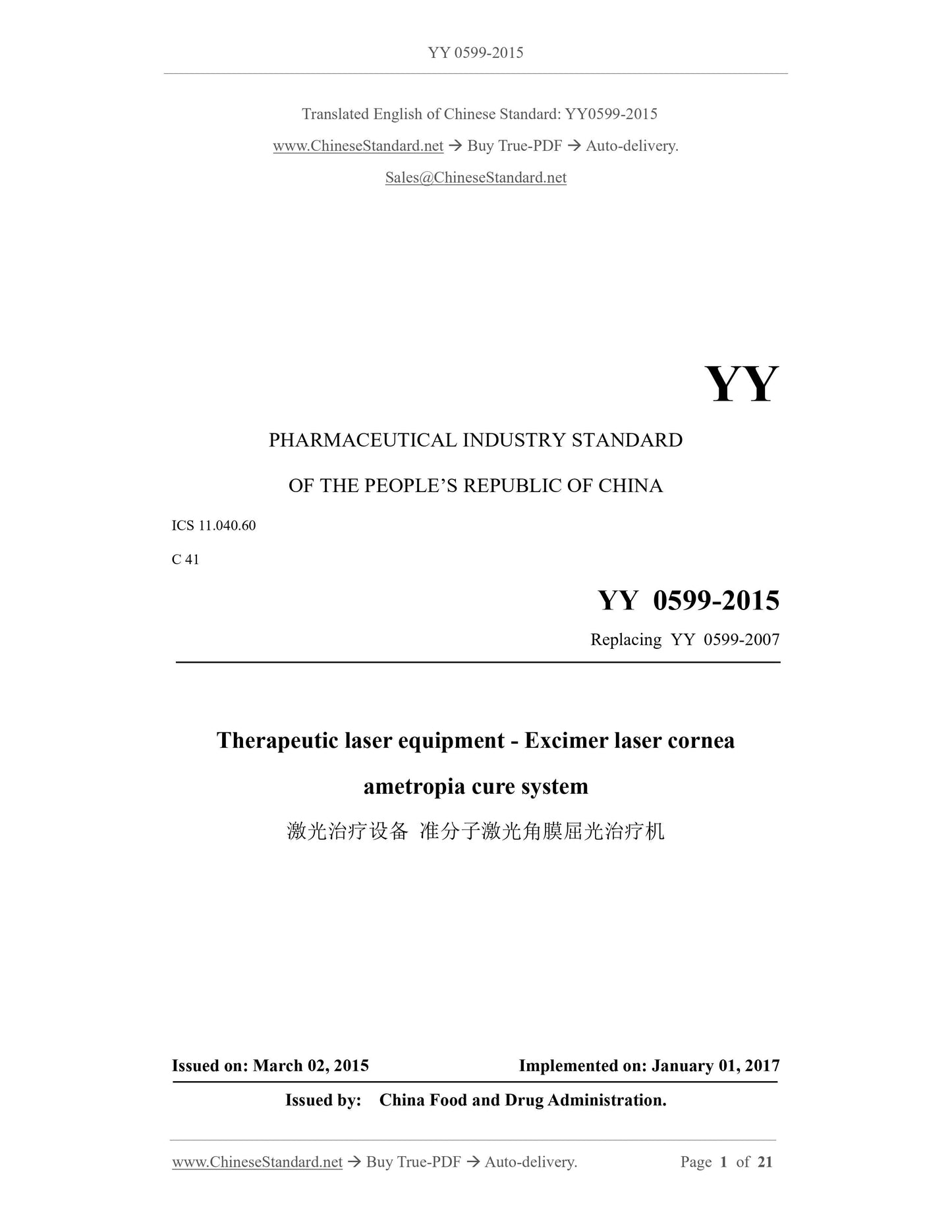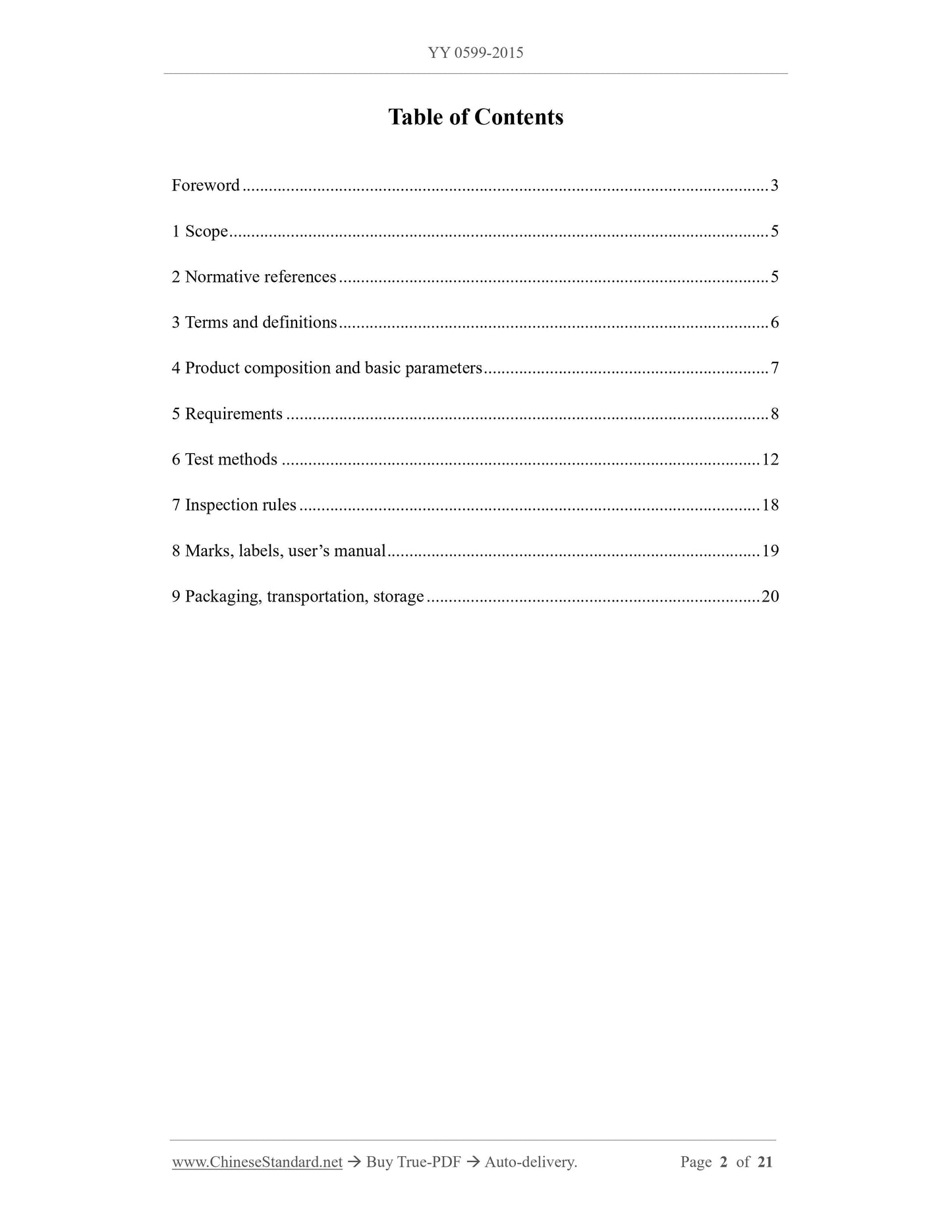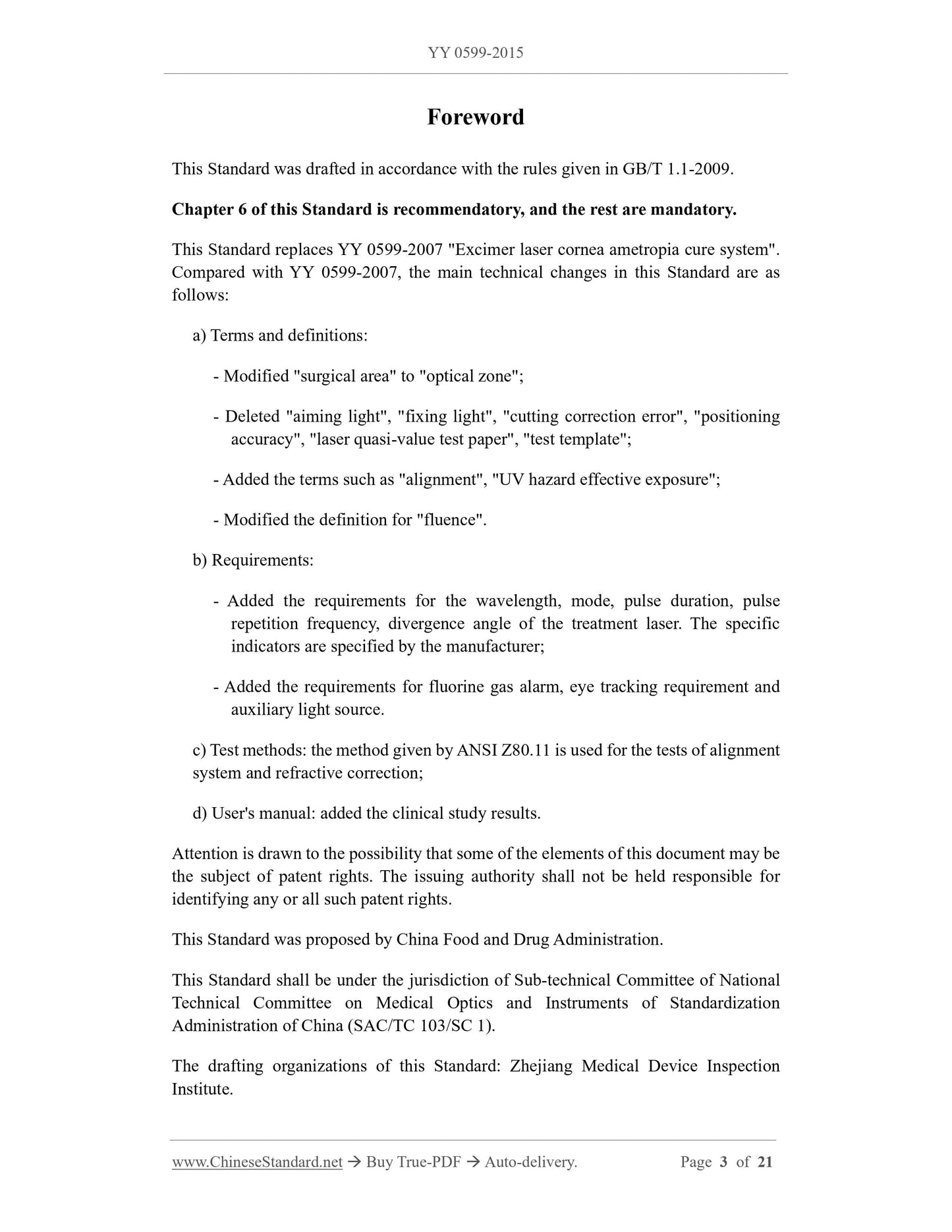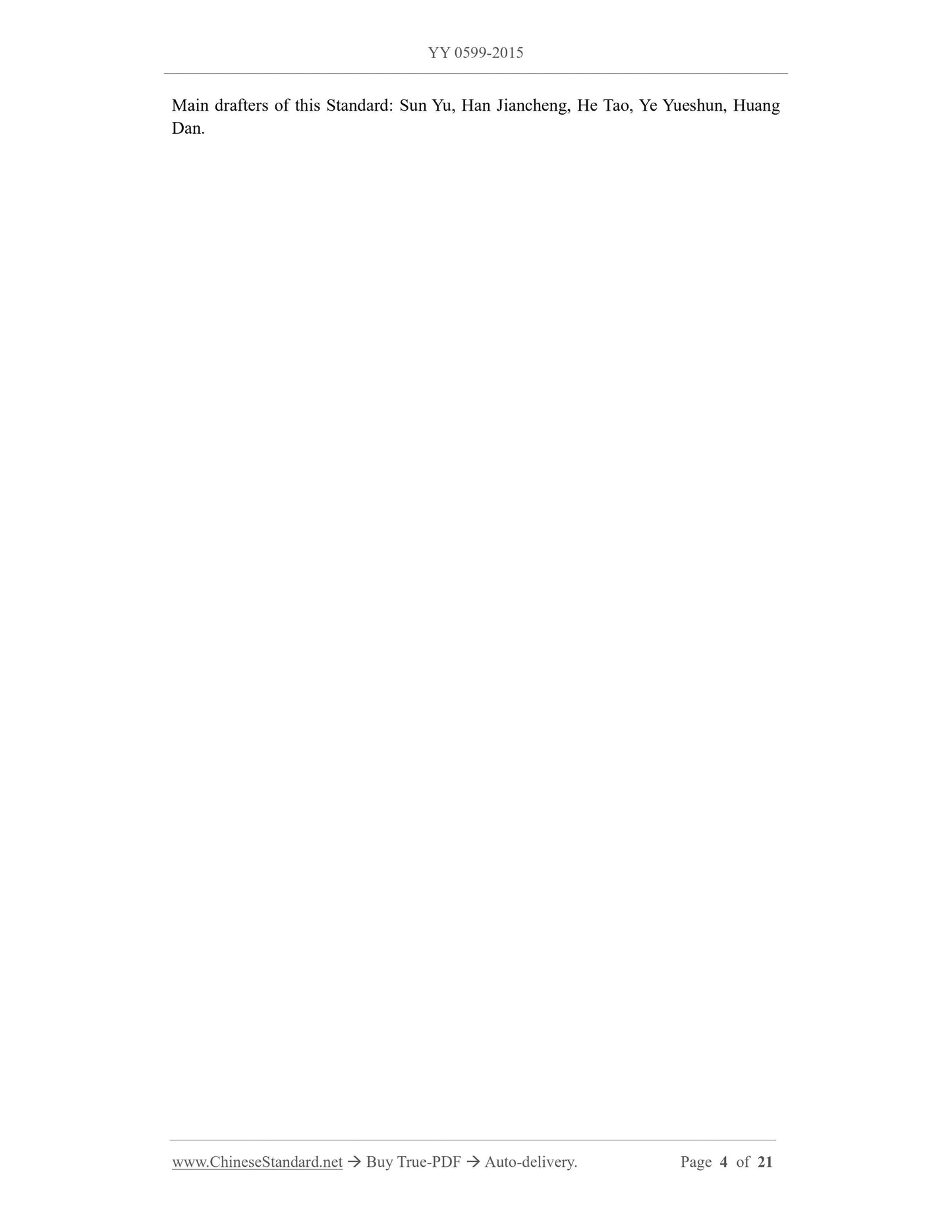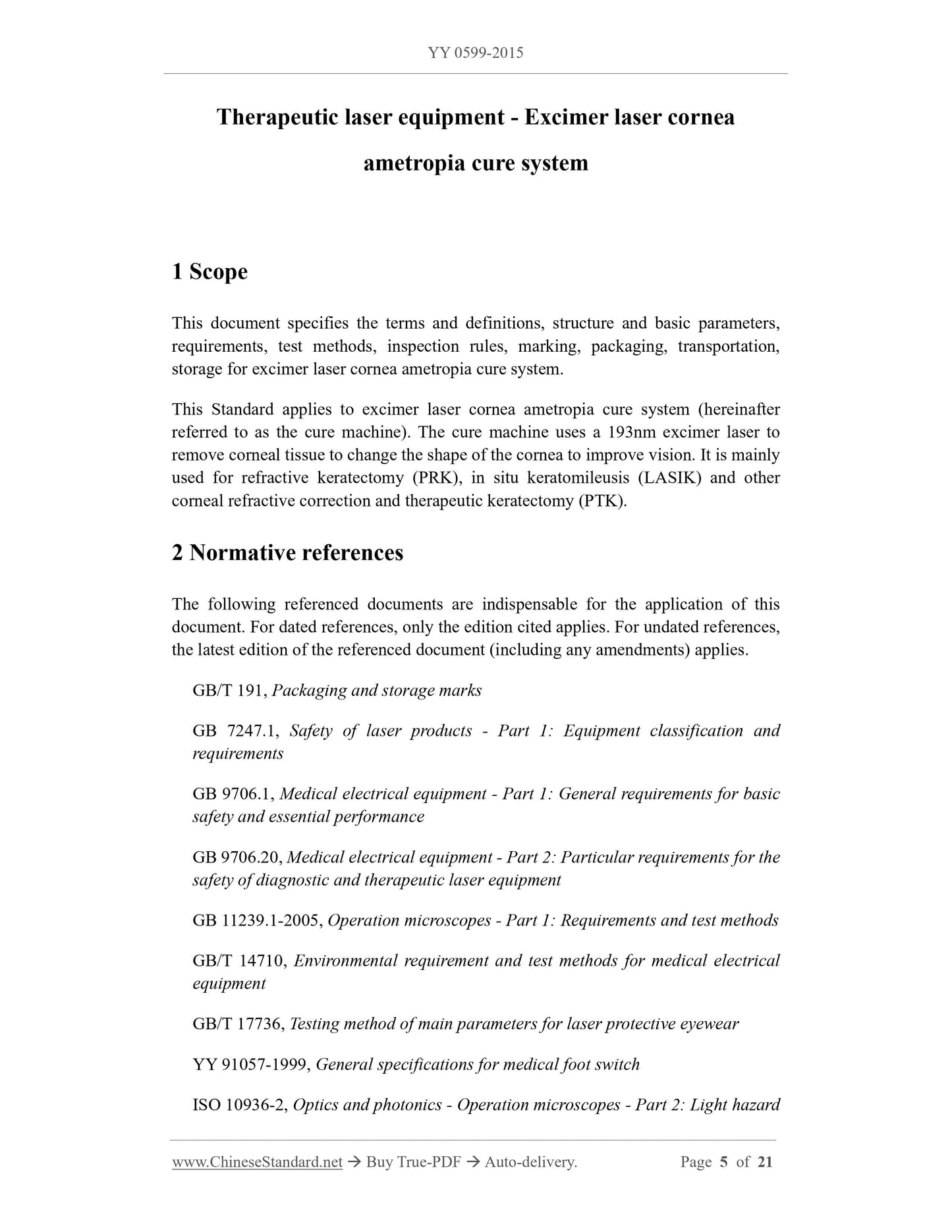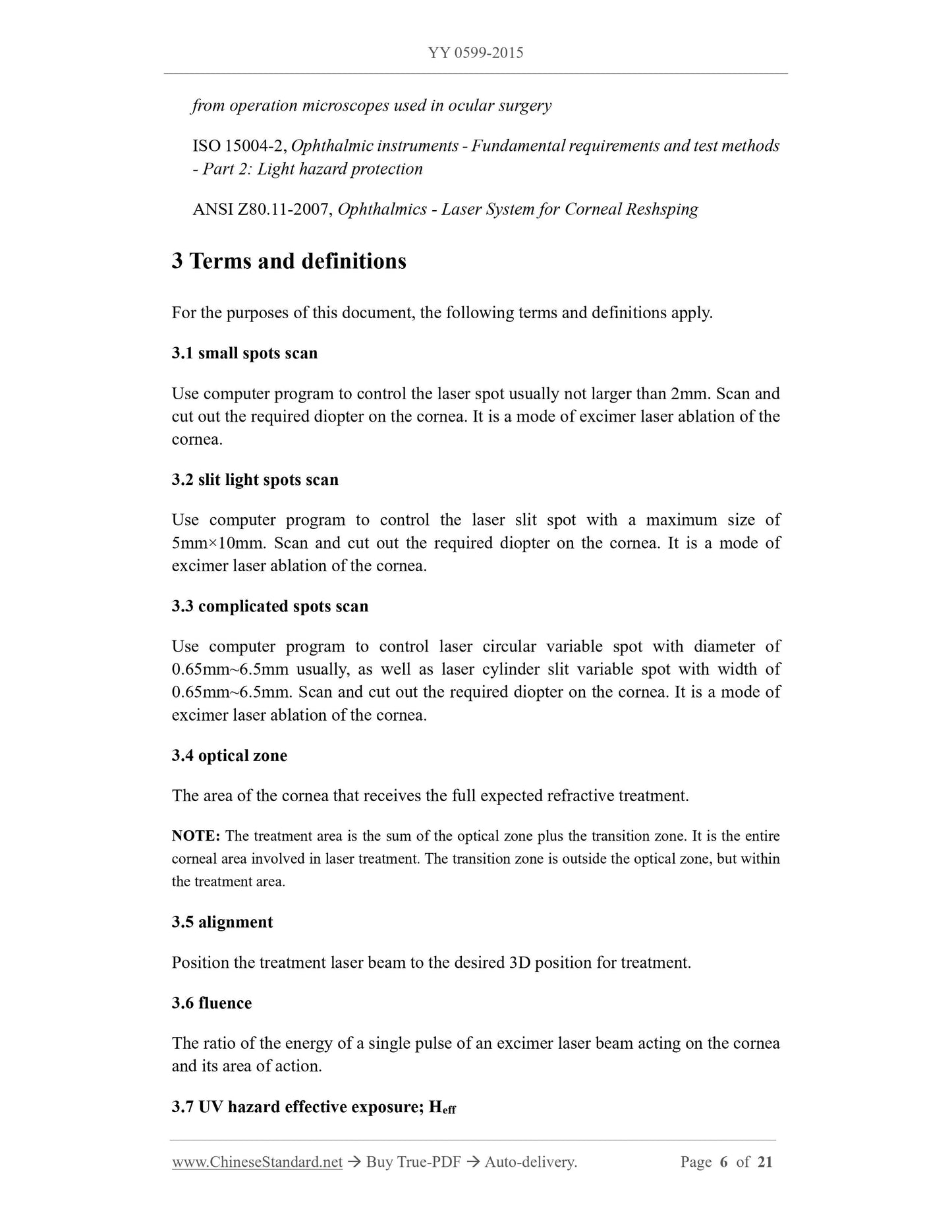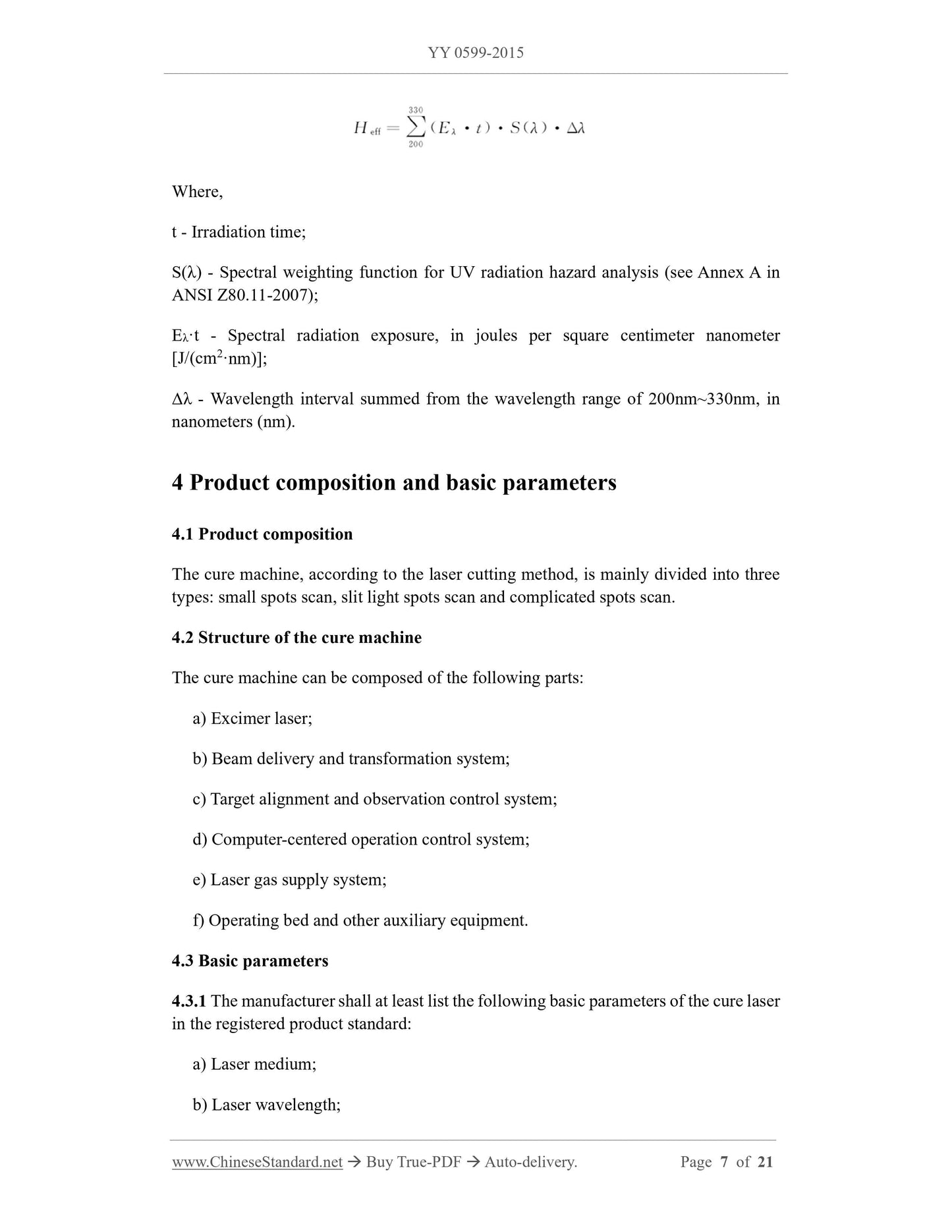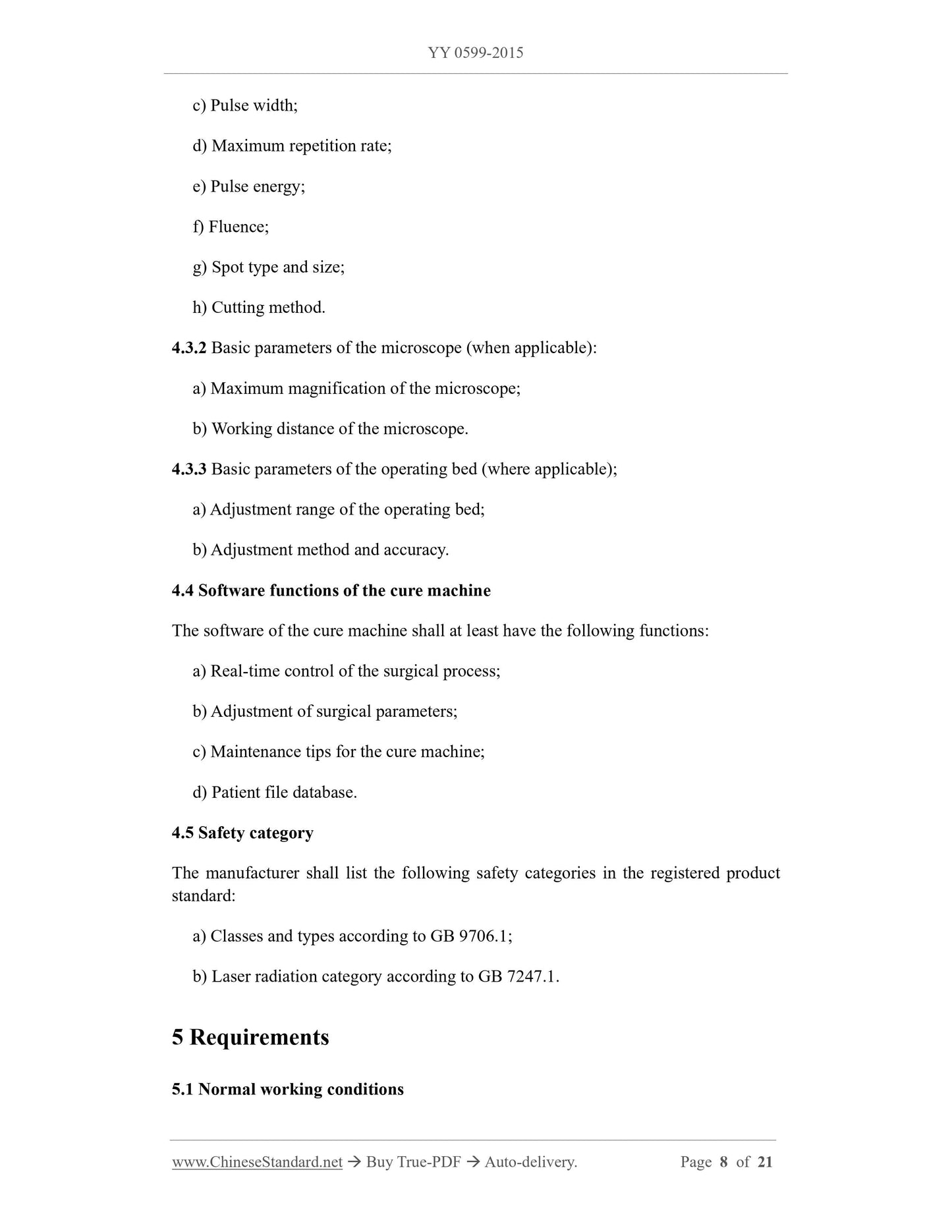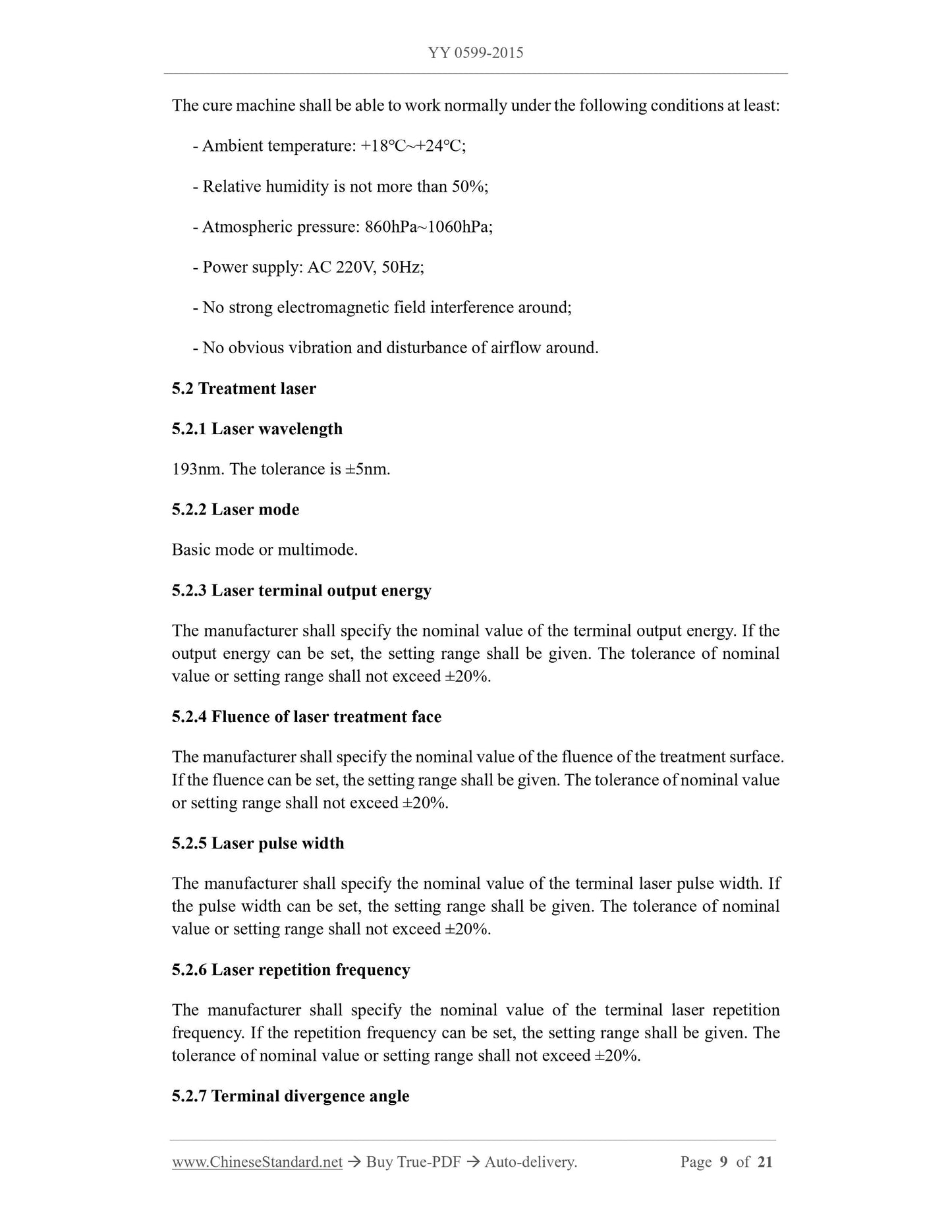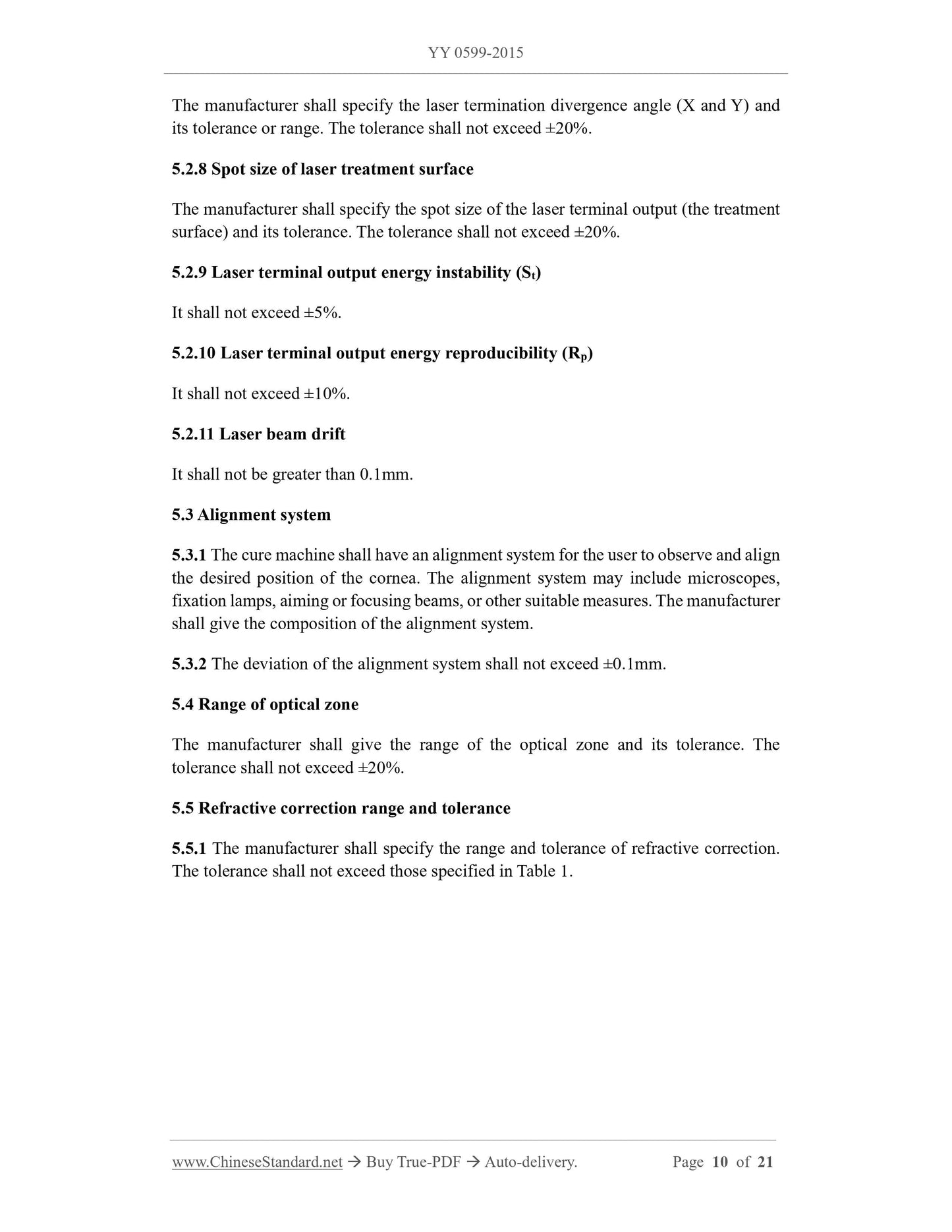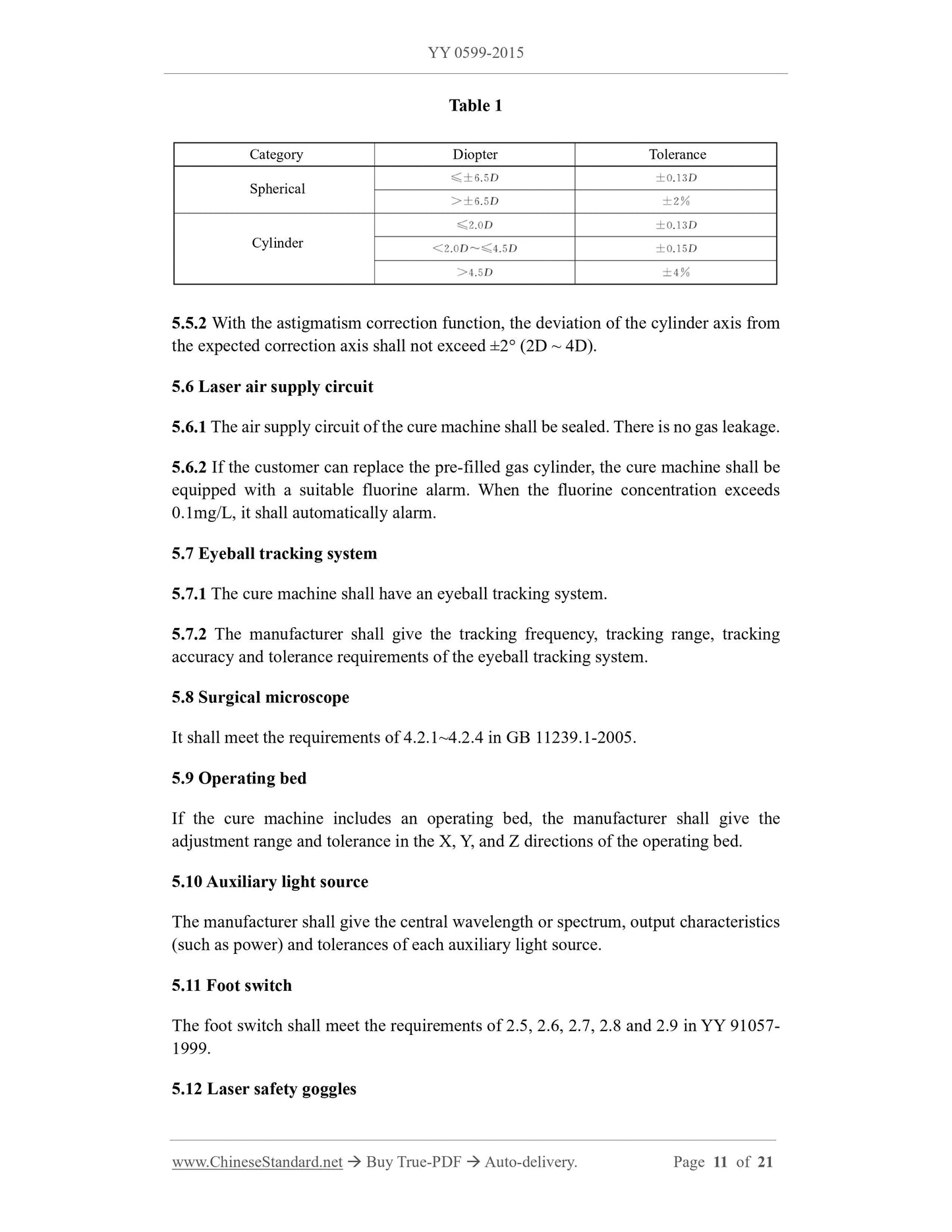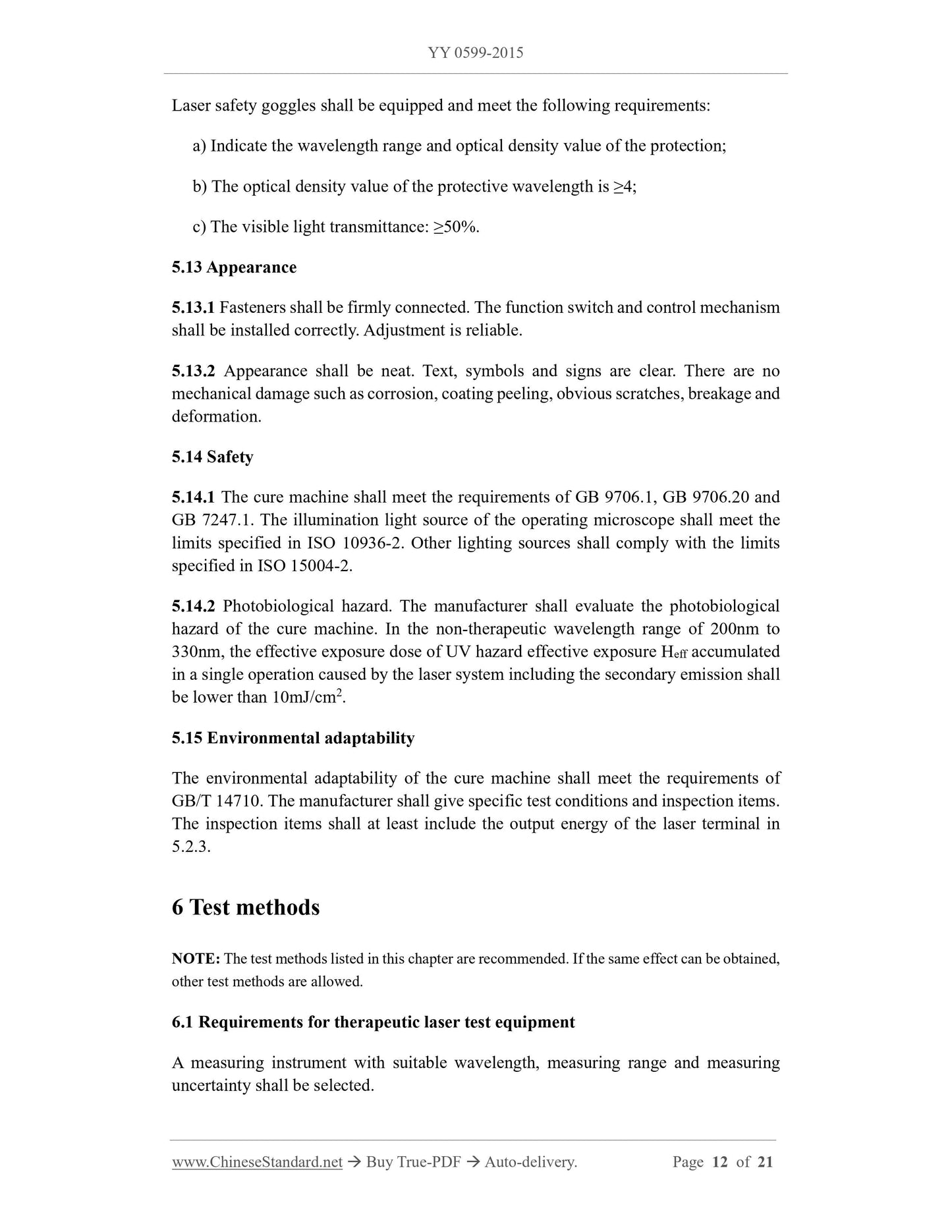1
/
su
12
PayPal, credit cards. Download editable-PDF & invoice in 1 second!
YY 0599-2015 English PDF (YY0599-2015)
YY 0599-2015 English PDF (YY0599-2015)
Prezzo di listino
$155.00 USD
Prezzo di listino
Prezzo scontato
$155.00 USD
Prezzo unitario
/
per
Spese di spedizione calcolate al check-out.
Impossibile caricare la disponibilità di ritiro
Delivery: 3 seconds. Download true-PDF + Invoice.
Get QUOTATION in 1-minute: Click YY 0599-2015
Historical versions: YY 0599-2015
Preview True-PDF (Reload/Scroll if blank)
YY 0599-2015: Therapeutic laser equipment. Excimer laser cornea ametropia cure system
YY 0599-2015
YY
PHARMACEUTICAL INDUSTRY STANDARD
OF THE PEOPLE’S REPUBLIC OF CHINA
ICS 11.040.60
C 41
Replacing YY 0599-2007
Therapeutic laser equipment - Excimer laser cornea
ametropia cure system
ISSUED ON: MARCH 02, 2015
IMPLEMENTED ON: JANUARY 01, 2017
Issued by: China Food and Drug Administration.
Table of Contents
Foreword ... 3
1 Scope ... 5
2 Normative references ... 5
3 Terms and definitions ... 6
4 Product composition and basic parameters ... 7
5 Requirements ... 8
6 Test methods ... 12
7 Inspection rules ... 18
8 Marks, labels, user’s manual ... 19
9 Packaging, transportation, storage ... 20
Therapeutic laser equipment - Excimer laser cornea
ametropia cure system
1 Scope
This document specifies the terms and definitions, structure and basic parameters,
requirements, test methods, inspection rules, marking, packaging, transportation,
storage for excimer laser cornea ametropia cure system.
This Standard applies to excimer laser cornea ametropia cure system (hereinafter
referred to as the cure machine). The cure machine uses a 193nm excimer laser to
remove corneal tissue to change the shape of the cornea to improve vision. It is mainly
used for refractive keratectomy (PRK), in situ keratomileusis (LASIK) and other
corneal refractive correction and therapeutic keratectomy (PTK).
2 Normative references
The following referenced documents are indispensable for the application of this
document. For dated references, only the edition cited applies. For undated references,
the latest edition of the referenced document (including any amendments) applies.
GB/T 191, Packaging and storage marks
GB 7247.1, Safety of laser products - Part 1: Equipment classification and
requirements
GB 9706.1, Medical electrical equipment - Part 1: General requirements for basic
safety and essential performance
GB 9706.20, Medical electrical equipment - Part 2: Particular requirements for the
safety of diagnostic and therapeutic laser equipment
GB 11239.1-2005, Operation microscopes - Part 1: Requirements and test methods
GB/T 14710, Environmental requirement and test methods for medical electrical
equipment
GB/T 17736, Testing method of main parameters for laser protective eyewear
YY 91057-1999, General specifications for medical foot switch
ISO 10936-2, Optics and photonics - Operation microscopes - Part 2: Light hazard
from operation microscopes used in ocular surgery
ISO 15004-2, Ophthalmic instruments - Fundamental requirements and test methods
- Part 2: Light hazard protection
ANSI Z80.11-2007, Ophthalmics - Laser System for Corneal Reshsping
3 Terms and definitions
For the purposes of this document, the following terms and definitions apply.
3.1 small spots scan
Use computer program to control the laser spot usually not larger than 2mm. Scan and
cut out the required diopter on the cornea. It is a mode of excimer laser ablation of the
cornea.
3.2 slit light spots scan
Use computer program to control the laser slit spot with a maximum size of
5mm×10mm. Scan and cut out the required diopter on the cornea. It is a mode of
excimer laser ablation of the cornea.
3.3 complicated spots scan
Use computer program to control laser circular variable spot with diameter of
0.65mm~6.5mm usually, as well as laser cylinder slit variable spot with width of
0.65mm~6.5mm. Scan and cut out the required diopter on the cornea. It is a mode of
excimer laser ablation of the cornea.
3.4 optical zone
The area of the cornea that receives the full expected refractive treatment.
NOTE: The treatment area is the sum of the optical zone plus the transition zone. It is the entire
corneal area involved in laser treatment. The transition zone is outside the optical zone, but within
the treatment area.
3.5 alignment
Position the treatment laser beam to the desired 3D position for treatment.
3.6 fluence
The ratio of the energy of a single pulse of an excimer laser beam acting on the cornea
and its area of action.
3.7 UV hazard effective exposure; Heff
The cure machine shall be able to work normally under the following conditions at least:
- Ambient temperature: +18℃~+24℃;
- Relative humidity is not more than 50%;
- Atmospheric pressure: 860hPa~1060hPa;
- Power supply: AC 220V, 50Hz;
- No strong electromagnetic field interference around;
- No obvious vibration and disturbance of airflow around.
5.2 Treatment laser
5.2.1 Laser wavelength
193nm. The tolerance is ±5nm.
5.2.2 Laser mode
Basic mode or multimode.
5.2.3 Laser terminal output energy
The manufacturer shall specify the nominal value of the terminal output energy. If the
output energy can be set, the setting range shall be given. The tolerance of nominal
value or setting range shall not exceed ±20%.
5.2.4 Fluence of laser treatment face
The manufacturer shall specify the nominal value of the fluence of the treatment surface.
If the fluence can be set, the setting range shall be given. The tolerance of nominal value
or setting range shall not exceed ±20%.
5.2.5 Laser pulse width
The manufacturer shall specify the nominal value of the terminal laser pulse width. If
the pulse width can be set, the setting range shall be given. The tolerance of nominal
value or setting range shall not exceed ±20%.
5.2.6 Laser repetition frequency
The manufacturer shall specify the nominal value of the terminal laser repetition
frequency. If the repetition frequency can be set, the setting range shall be given. The
tolerance of nominal value or setting range shall not exceed ±20%.
5.2.7 Terminal divergence angle
The manufacturer shall specify the laser termination divergence angle (X and Y) and
its tolerance or range. The tolerance shall not exceed ±20%.
5.2.8 Spot size of laser treatment surface
The manufacturer shall specify the spot size of the laser terminal output (the treatment
surface) and its tolerance. The tolerance shall not exceed ±20%.
5.2.9 Laser terminal output energy instability (St)
It shall not exceed ±5%.
5.2.10 Laser terminal output energy reproducibility (Rp)
It shall not exceed ±10%.
5.2.11 Laser beam drift
It shall not be greater than 0.1mm.
5.3 Alignment system
5.3.1 The cure machine shall have an alignment system for the user to observe and align
the desired position of the cornea. The alignment system may include microscopes,
fixation lamps, aiming or focusing beams, or other suitable measures. The manufacturer
shall give the composition of the alignment system.
5.3.2 The deviation of the alignment system shall not exceed ±0.1mm.
5.4 Range of optical zone
The manufacturer shall give the range of the optical zone and its tolerance. The
tolerance shall not exceed ±20%.
5.5 Refractive correction range and tolerance
5.5.1 The manufacturer shall specify the range and tolerance of refractive correction.
The tolerance shall not exceed those specified in Table 1.
Laser safety goggles shall be equipped and meet the following requirements:
a) Indicate the wavelength range and optical density value of the protection;
b) The optical density value of the protective wavelength is ≥4;
c) The visible light transmittance: ≥50%.
5.13 Appearance
5.13.1 Fasteners shall be firmly connected. The function switch and control mechanism
shall be installed correctly. Adjustment is reliable.
5.13.2 Appearance shall be neat. Text, symbols and signs are clear. There are no
mechanic...
Get QUOTATION in 1-minute: Click YY 0599-2015
Historical versions: YY 0599-2015
Preview True-PDF (Reload/Scroll if blank)
YY 0599-2015: Therapeutic laser equipment. Excimer laser cornea ametropia cure system
YY 0599-2015
YY
PHARMACEUTICAL INDUSTRY STANDARD
OF THE PEOPLE’S REPUBLIC OF CHINA
ICS 11.040.60
C 41
Replacing YY 0599-2007
Therapeutic laser equipment - Excimer laser cornea
ametropia cure system
ISSUED ON: MARCH 02, 2015
IMPLEMENTED ON: JANUARY 01, 2017
Issued by: China Food and Drug Administration.
Table of Contents
Foreword ... 3
1 Scope ... 5
2 Normative references ... 5
3 Terms and definitions ... 6
4 Product composition and basic parameters ... 7
5 Requirements ... 8
6 Test methods ... 12
7 Inspection rules ... 18
8 Marks, labels, user’s manual ... 19
9 Packaging, transportation, storage ... 20
Therapeutic laser equipment - Excimer laser cornea
ametropia cure system
1 Scope
This document specifies the terms and definitions, structure and basic parameters,
requirements, test methods, inspection rules, marking, packaging, transportation,
storage for excimer laser cornea ametropia cure system.
This Standard applies to excimer laser cornea ametropia cure system (hereinafter
referred to as the cure machine). The cure machine uses a 193nm excimer laser to
remove corneal tissue to change the shape of the cornea to improve vision. It is mainly
used for refractive keratectomy (PRK), in situ keratomileusis (LASIK) and other
corneal refractive correction and therapeutic keratectomy (PTK).
2 Normative references
The following referenced documents are indispensable for the application of this
document. For dated references, only the edition cited applies. For undated references,
the latest edition of the referenced document (including any amendments) applies.
GB/T 191, Packaging and storage marks
GB 7247.1, Safety of laser products - Part 1: Equipment classification and
requirements
GB 9706.1, Medical electrical equipment - Part 1: General requirements for basic
safety and essential performance
GB 9706.20, Medical electrical equipment - Part 2: Particular requirements for the
safety of diagnostic and therapeutic laser equipment
GB 11239.1-2005, Operation microscopes - Part 1: Requirements and test methods
GB/T 14710, Environmental requirement and test methods for medical electrical
equipment
GB/T 17736, Testing method of main parameters for laser protective eyewear
YY 91057-1999, General specifications for medical foot switch
ISO 10936-2, Optics and photonics - Operation microscopes - Part 2: Light hazard
from operation microscopes used in ocular surgery
ISO 15004-2, Ophthalmic instruments - Fundamental requirements and test methods
- Part 2: Light hazard protection
ANSI Z80.11-2007, Ophthalmics - Laser System for Corneal Reshsping
3 Terms and definitions
For the purposes of this document, the following terms and definitions apply.
3.1 small spots scan
Use computer program to control the laser spot usually not larger than 2mm. Scan and
cut out the required diopter on the cornea. It is a mode of excimer laser ablation of the
cornea.
3.2 slit light spots scan
Use computer program to control the laser slit spot with a maximum size of
5mm×10mm. Scan and cut out the required diopter on the cornea. It is a mode of
excimer laser ablation of the cornea.
3.3 complicated spots scan
Use computer program to control laser circular variable spot with diameter of
0.65mm~6.5mm usually, as well as laser cylinder slit variable spot with width of
0.65mm~6.5mm. Scan and cut out the required diopter on the cornea. It is a mode of
excimer laser ablation of the cornea.
3.4 optical zone
The area of the cornea that receives the full expected refractive treatment.
NOTE: The treatment area is the sum of the optical zone plus the transition zone. It is the entire
corneal area involved in laser treatment. The transition zone is outside the optical zone, but within
the treatment area.
3.5 alignment
Position the treatment laser beam to the desired 3D position for treatment.
3.6 fluence
The ratio of the energy of a single pulse of an excimer laser beam acting on the cornea
and its area of action.
3.7 UV hazard effective exposure; Heff
The cure machine shall be able to work normally under the following conditions at least:
- Ambient temperature: +18℃~+24℃;
- Relative humidity is not more than 50%;
- Atmospheric pressure: 860hPa~1060hPa;
- Power supply: AC 220V, 50Hz;
- No strong electromagnetic field interference around;
- No obvious vibration and disturbance of airflow around.
5.2 Treatment laser
5.2.1 Laser wavelength
193nm. The tolerance is ±5nm.
5.2.2 Laser mode
Basic mode or multimode.
5.2.3 Laser terminal output energy
The manufacturer shall specify the nominal value of the terminal output energy. If the
output energy can be set, the setting range shall be given. The tolerance of nominal
value or setting range shall not exceed ±20%.
5.2.4 Fluence of laser treatment face
The manufacturer shall specify the nominal value of the fluence of the treatment surface.
If the fluence can be set, the setting range shall be given. The tolerance of nominal value
or setting range shall not exceed ±20%.
5.2.5 Laser pulse width
The manufacturer shall specify the nominal value of the terminal laser pulse width. If
the pulse width can be set, the setting range shall be given. The tolerance of nominal
value or setting range shall not exceed ±20%.
5.2.6 Laser repetition frequency
The manufacturer shall specify the nominal value of the terminal laser repetition
frequency. If the repetition frequency can be set, the setting range shall be given. The
tolerance of nominal value or setting range shall not exceed ±20%.
5.2.7 Terminal divergence angle
The manufacturer shall specify the laser termination divergence angle (X and Y) and
its tolerance or range. The tolerance shall not exceed ±20%.
5.2.8 Spot size of laser treatment surface
The manufacturer shall specify the spot size of the laser terminal output (the treatment
surface) and its tolerance. The tolerance shall not exceed ±20%.
5.2.9 Laser terminal output energy instability (St)
It shall not exceed ±5%.
5.2.10 Laser terminal output energy reproducibility (Rp)
It shall not exceed ±10%.
5.2.11 Laser beam drift
It shall not be greater than 0.1mm.
5.3 Alignment system
5.3.1 The cure machine shall have an alignment system for the user to observe and align
the desired position of the cornea. The alignment system may include microscopes,
fixation lamps, aiming or focusing beams, or other suitable measures. The manufacturer
shall give the composition of the alignment system.
5.3.2 The deviation of the alignment system shall not exceed ±0.1mm.
5.4 Range of optical zone
The manufacturer shall give the range of the optical zone and its tolerance. The
tolerance shall not exceed ±20%.
5.5 Refractive correction range and tolerance
5.5.1 The manufacturer shall specify the range and tolerance of refractive correction.
The tolerance shall not exceed those specified in Table 1.
Laser safety goggles shall be equipped and meet the following requirements:
a) Indicate the wavelength range and optical density value of the protection;
b) The optical density value of the protective wavelength is ≥4;
c) The visible light transmittance: ≥50%.
5.13 Appearance
5.13.1 Fasteners shall be firmly connected. The function switch and control mechanism
shall be installed correctly. Adjustment is reliable.
5.13.2 Appearance shall be neat. Text, symbols and signs are clear. There are no
mechanic...
Share
